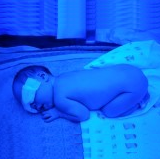Which treatment option should I go for if my baby is jaundiced?

babyadmin |
Hospital versus Home treatments
If your baby has jaundice, the best course of action is phototherapy. However, you may be trying to decide whether to have your baby treated in the hospital or at home. There are advantages and disadvantages to both.
Jaundiced babies have to be screened by their doctor before they can have the go-ahead to be treated at home. Phototherapy treatment at home requires greater responsibility from parents and caregivers to adhere to the baby’s treatment plan. This includes placing the baby under the phototherapy lights for as long as possible to allow the light treatment to take place. Parents have to resist the urge to pick the baby up too frequently; otherwise the treatment will not be effective.
However, there are tremendous benefits of treating jaundice at home. Being at home puts you and your baby at greater ease, and you can bond and breastfeed your baby without any disruption. Not having to stay in the hospital also reduces the chances of babies picking up hospital-acquired infections, such as the methicillin-resistant staphylococcus aureus bacteria (MRSA) bacteria.
Phototherapy treatment in the hospital may also be costly. Two days of phototherapy in a single room at a private hospital may cost approximately $1800 and this excludes the paediatrician’s fees.
In comparison, rental of Medela home phototherapy equipment, the same brand of equipment as they use in the hospital, costs about $300 for the same treatment period. Many leading private and government hospitals in Singapore also use the Medela and Natus Phototherapy equipment in their nurseries and NICU.
Fibreoptic versus conventional phototherapy
In conventional phototherapy, your baby is put under or above a blue-light-emitting fluorescent or halogen bulb for three to four hours at a stretch. Throughout the treatment, your baby's eyes will be protected from the light with an eye protection mask. Between two sessions, there will be a break of half an hour that will give you the opportunity to pick up your baby for feeding or simply skin-t0-skin contact. When your baby is removed from under or above the equipment, he or she does not receive the light treatment. Hence you should try to keep the breaks short to ensure your baby gets the full length of the light treatment. Generally, phototherapy treatment should be completed in two to three days.
In fibreoptic phototherapy treatment, your baby lies on a light pad that has fibreoptic cables woven into it. Blue light from the light pad will shine on your baby's back. There is no need to break the phototherapy treatment for feeding, as you can hold your baby with the light pad underneath your baby and breastfeed while he or she is getting phototherapy treatment. As with conventional phototherapy, two or three days in the fibreoptic phototherapy treatment should suffice to bring your baby's bilirubin levels down.
Nowadays, your baby has the option of getting conventional or fibreoptic phototherapy treatment at the hospital or at home. Both options are safe and convenient as the home phototherapy packages from The Baby Specialist include services from a trained technician who will come to your home to deliver and set up the hospital-grade phototherapy equipment. He will also walk you through the operation of these equipment so that you can give your baby the best care possible.
